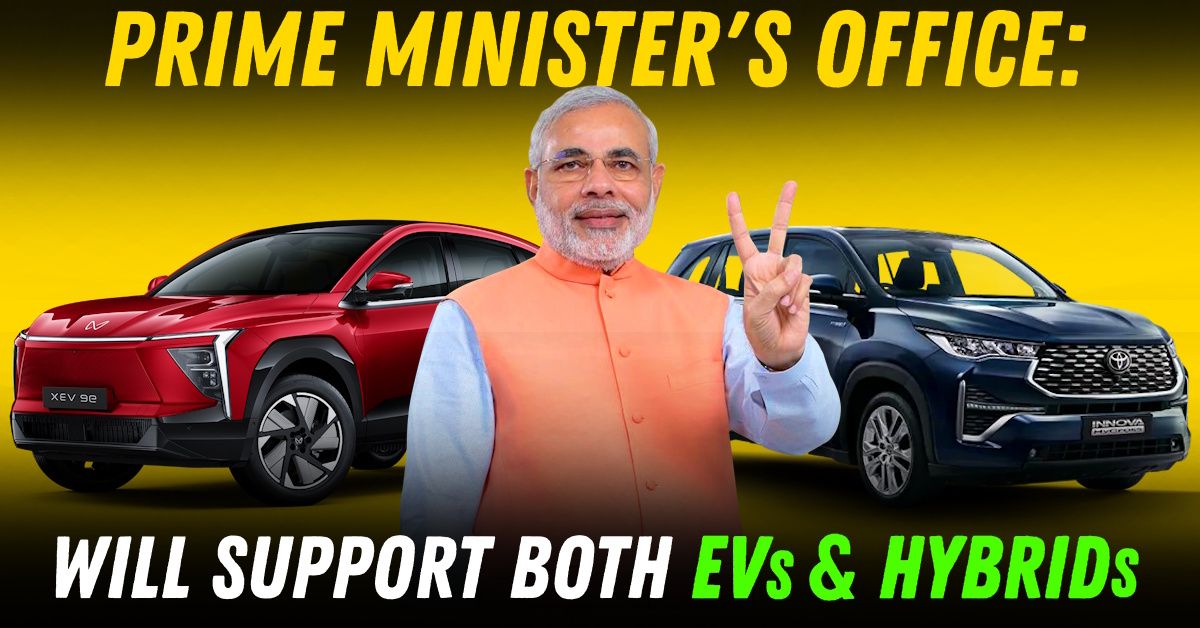Prime Minister's Office: Won't Favour EVs Over Hybrids, All Clean Mobility Equal


In a move that could redefine India’s approach to green transport, the Prime Minister’s Office (PMO) has made it clear that electric vehicles will not be given exclusive preference over other clean-fuel technologies, reports LiveMint. Instead, the Union government is opting for a broader, more inclusive policy framework that supports both EVs and hybrids, along with CNG and LPG-powered vehicles. The objective is straightforward: reduce oil imports and emissions without locking into a single solution.
Officials familiar with ongoing policy discussions say the PMO's stance is driven by a desire to keep India's clean mobility path flexible. Rather than betting everything on battery-powered vehicles, the government wants to encourage any technology that helps cut fossil fuel use and lowers emissions. This includes hybrids, which offer an immediate reduction in fuel consumption without the dependence on charging infrastructure.
This position is not a retreat from EVs, but a recalibration. With infrastructure still catching up and consumer apprehensions around range and cost lingering, a hybrid-inclusive strategy could accelerate the shift to greener transport without alienating large swathes of the market.
There’s a growing recognition that EVs and hybrids are not direct rivals. EVs have gained popularity in cities where charging networks are more robust and daily driving ranges are modest. Hybrids, meanwhile, are catching on with buyers in areas where charging access is scarce or unreliable.
Data from global and domestic markets shows that where hybrids thrive, EVs also grow. The two are not in competition as much as they are expanding parallel tracks within the same clean mobility narrative. For many buyers, hybrids serve as a gateway, an introduction to electrified motoring without range anxiety or infrastructure constraints.
While the spotlight has often been on EVs, hybrids have not been ignored. From the National Electric Mobility Mission Plan launched in 2013 to the FAME schemes that followed, hybrids have remained eligible for incentives. The recently introduced PM E-DRIVE scheme continues this legacy, including hybrid ambulances in its subsidy pool and allocating funds to expand nationwide charging infrastructure.
This continuity suggests that hybrid support is not new, even if it hasn’t grabbed headlines. What’s different now is the clearer messaging from the top, signalling that hybrids are not a second-tier solution, they are part of the main strategy.
State governments have adopted widely different models when it comes to promoting clean vehicles. Maharashtra, Uttar Pradesh and a few others offer generous subsidies for both EVs and hybrids. In contrast, some states focus narrowly on tax waivers or registration rebates.
This decentralised approach has created pockets of strong adoption and experimentation. But it also means that a buyer’s access to incentives often depends on their pin code, not their intent to go green. The Centre’s neutral stance could help create more consistency in how different vehicle types are promoted nationwide.
Even as the number of public chargers grows in urban areas, large parts of rural and semi-urban India still lack adequate charging options. This remains one of the most significant bottlenecks in EV adoption. For now, hybrids offer a workable compromise, cleaner than petrol or diesel but independent of charging grids.
Government funding is flowing into new stations and grid upgrades, but full nationwide coverage will take time. Until then, hybrids are likely to remain a sensible choice for many, especially outside metro areas.
India’s auto industry is undergoing a major transformation. Supporting both hybrids and EVs allows automakers and suppliers to transition more gradually, without dismantling existing production setups overnight. This dual-tech strategy helps preserve jobs and manufacturing capabilities while also encouraging innovation in next-gen powertrains.
From a consumer standpoint, more choice means more confidence. People are more likely to embrace clean mobility when they’re not forced to pick from a limited menu.
This policy direction tells us something important about the government’s long-term view. India is no longer interested in making declarations like going all-electric by 2030 or banning internal combustion engines overnight.
Instead, the approach is grounded in realism, encourage clean alternatives, allow different technologies to evolve, and let the market and infrastructure catch up over time.
Hybrids, therefore, are not a distraction. They are part of the bridge that will take India from combustion to electric, at a pace that’s both economically and socially sustainable.